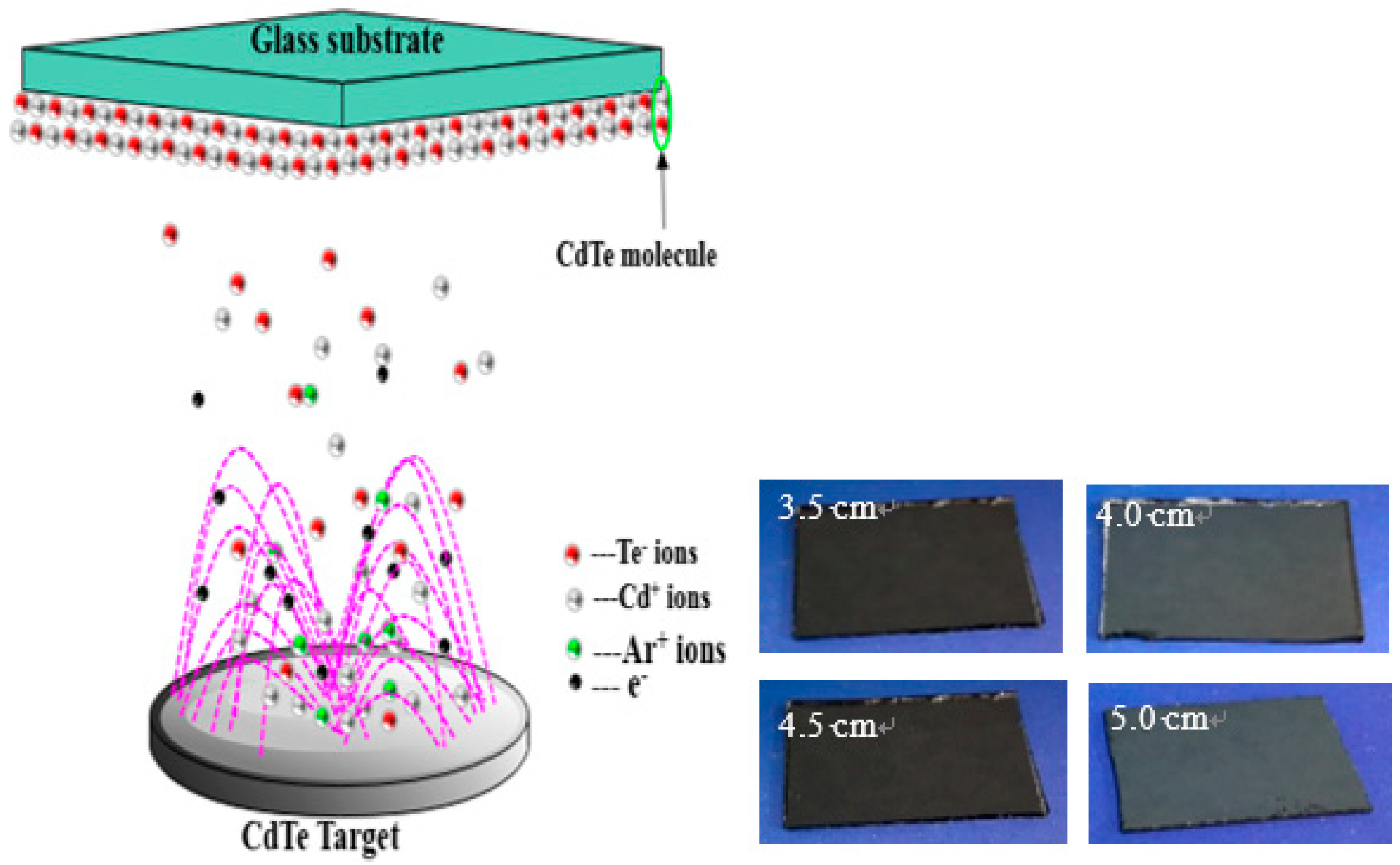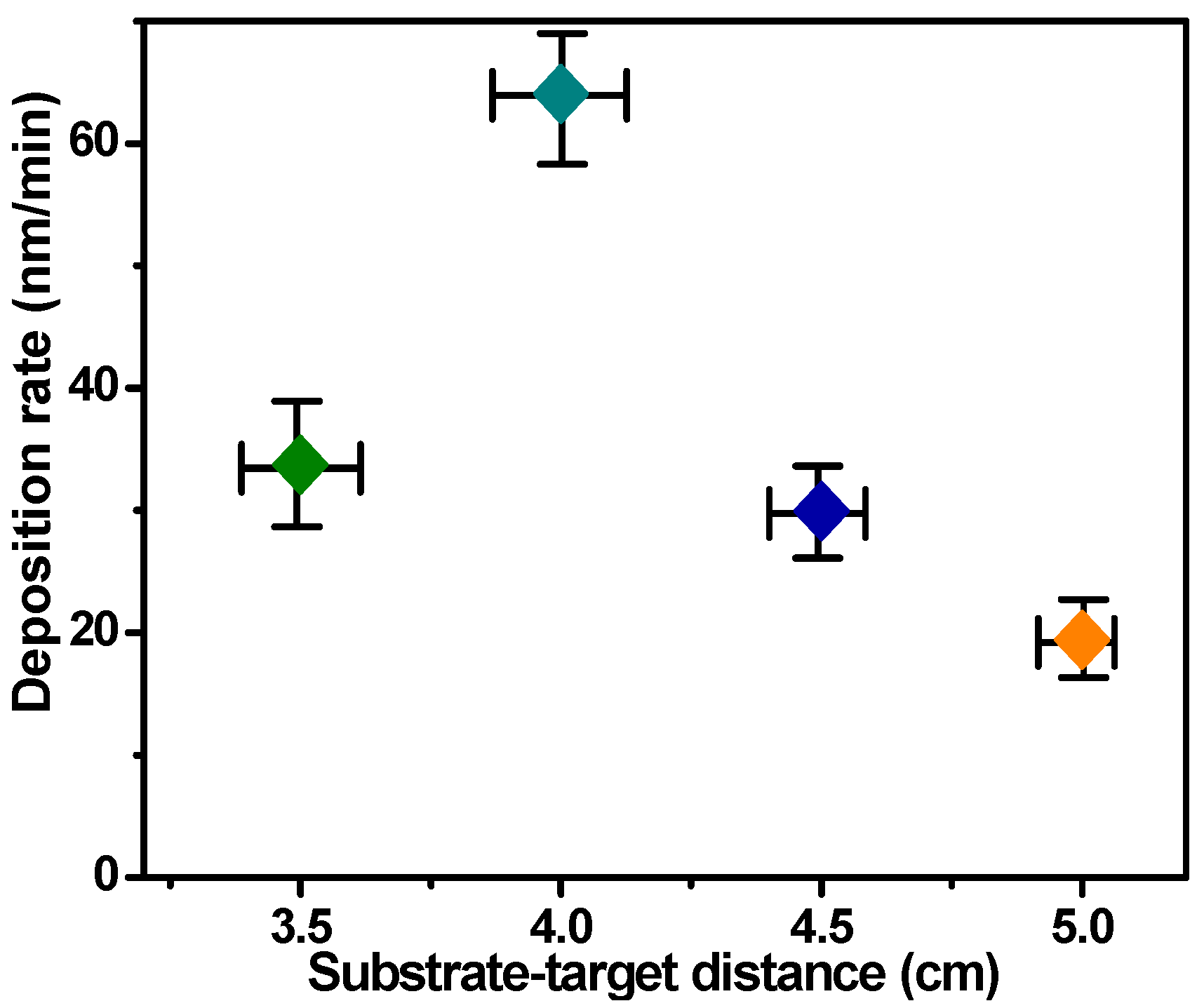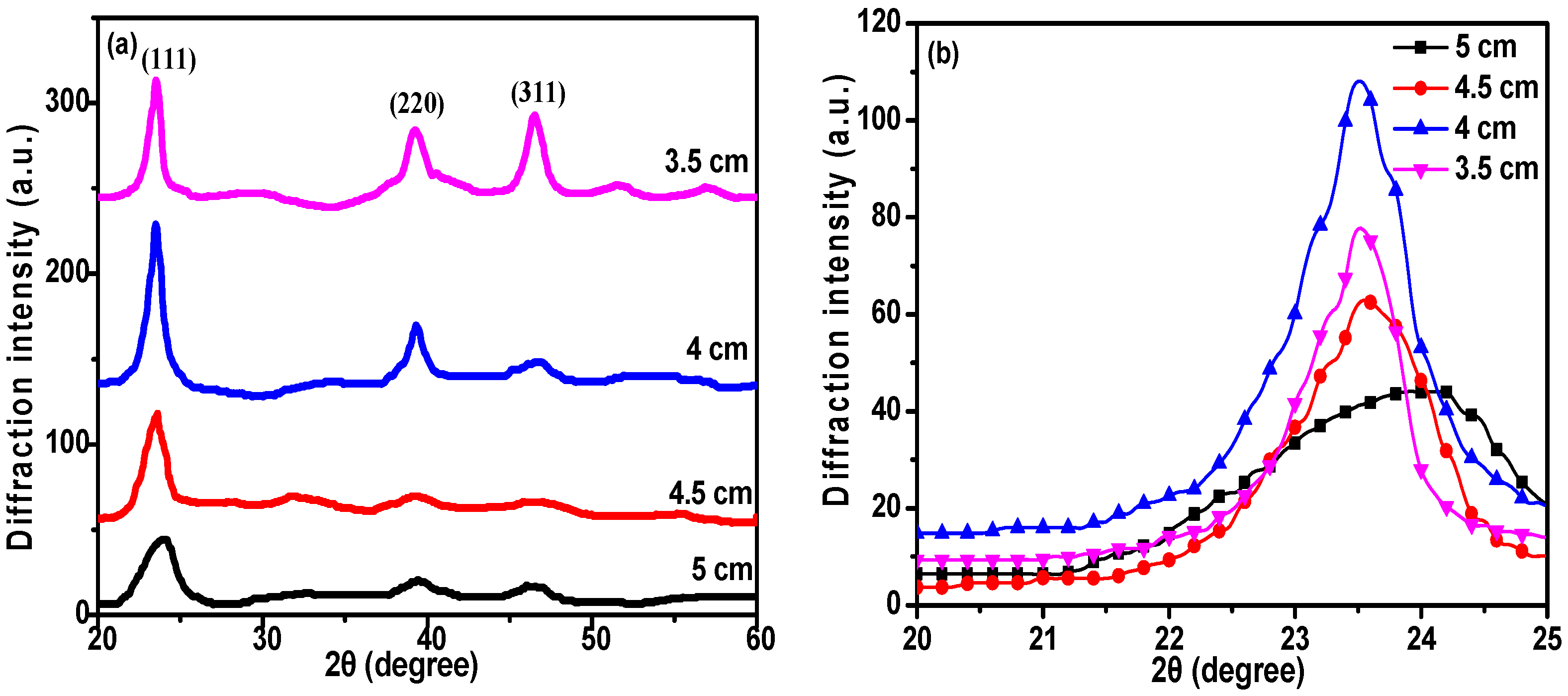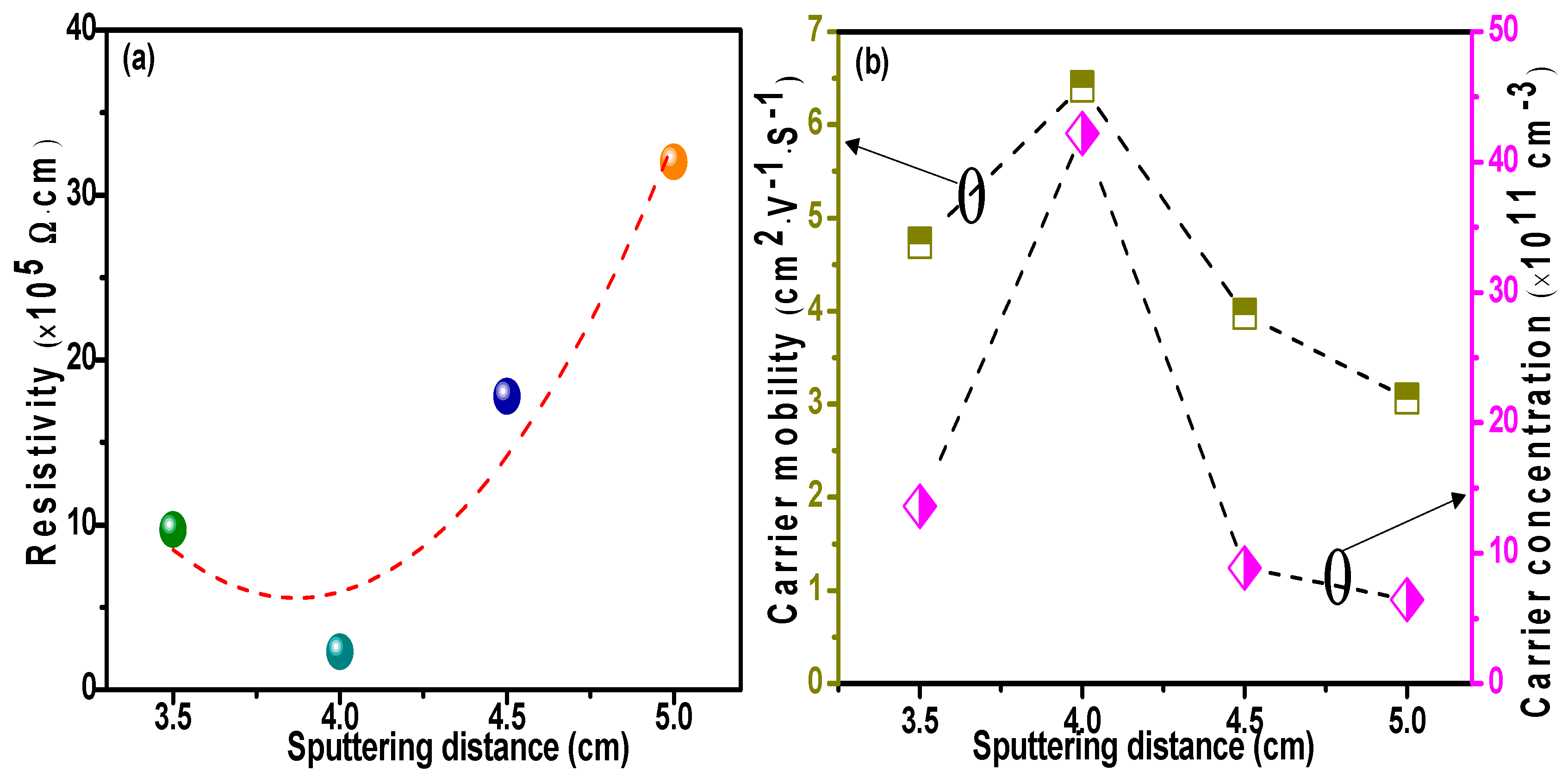Regulation of Substrate-Target Distance on the Microstructural, Optical and Electrical Properties of CdTe Films by Magnetron Sputtering
Abstract
:1. Introduction
2. Materials and Methods
3. Results and Discussion
4. Conclusions
Author Contributions
Funding
Acknowledgments
Conflicts of Interest
References
- Zhao, J.; Wang, A.; Green, M.A.; Ferrazza, F. 19.8% efficient “honeycomb” textured multicrystalline and 24.4% monocrystalline silicon solar cells. Appl. Phys. Lett. 1998, 73, 1991–1993. [Google Scholar] [CrossRef]
- Richards, B.S. Enhancing the performance of silicon solar cells via the application of passive luminescence conversion layers. Sol. Energy Mater. Sol. Cells 2006, 90, 2329–2337. [Google Scholar] [CrossRef]
- Kulkarni, R.; Pawbake, A.; Waykar, R. Substrate temperature dependent structural, optical, morphology and electrical properties of RF sputtered CdTe thin films for solar cell application. J. Mater. Sci. Mater. Electron. 2016, 27, 12405–12411. [Google Scholar] [CrossRef]
- Wang, J.J.; Fang, Z.B.; Ji, T. Band offsets of epitaxial Tm2O3 high-k dielectric films on Si substrates by X-ray photoelectron spectroscopy. Appl. Surf. Sci. 2012, 258, 6107–6110. [Google Scholar] [CrossRef]
- Chander, S.; Dhaka, D.S. Optimization of physical properties of vacuum evaporated CdTe thin films with the application of thermal treatment for solar cells. Mater. Sci. Semicond. Process. 2015, 40, 708–712. [Google Scholar] [CrossRef]
- Zhao, Y.; Boccard, M.; Liu, S.; Becker, J. Monocrystalline CdTe solar cells with open-circuit voltage over 1 V and efficiency of 17%. Nat. Energy 2016, 1, 16067. [Google Scholar] [CrossRef]
- Sharma, R.K.; Rastogi, A.C.; Jain, K.; Singh, G. Microstructural investigations on CdTe thin films electrodeposited using high current pulses. Physica B 2005, 366, 80–88. [Google Scholar] [CrossRef]
- Akhlesh, G. All-sputtered 14% CdS/CdTe thin-film solar cell with ZnO:Al transparent conducting oxide. Appl. Phys. Lett. 2004, 85, 684–686. [Google Scholar]
- Ferekides, C.S.; Balasubramanian, U.; Mamazza, R.; Viswanathan, V. CdTe thin film solar cells: Device and technology issues. Sol. Energy 2004, 77, 823–830. [Google Scholar] [CrossRef]
- Xia, W.; Lin, H.; Wu, H.N.; Tang, C.W. Effects of high-temperature annealing on ultra-thin CdTe solar cells. Thin Solid Films 2011, 520, 563–568. [Google Scholar] [CrossRef]
- Bas, A.K.; Oleg, S. Role of oxygen during CdTe growth for CdTe photovoltaic devices. Prog. Photovolt. Res. Appl. 2014, 22, 1040–1049. [Google Scholar]
- Tang, K.; Zhu, X.T.; Bai, W. Molecular beam epitaxial growth and optical properties of the CdTe thin films on highly mismatched SrTiO3 substrates. J. Alloys Compd. 2016, 685, 370–375. [Google Scholar] [CrossRef]
- Pandey, S.K.; Tiwari, U.; Raman, R. Growth of cubic and hexagonal CdTe thin films by pulsed laser deposition. Thin Solid Films 2005, 473, 54–57. [Google Scholar] [CrossRef]
- Mandal, S.K.; Chaudhuri, S.; Pal, A.K. Nanocrystalline CdTe films deposited by high-pressure sputtering: Carrier transport at low temperature. Thin Solid Films 1999, 357, 102–110. [Google Scholar] [CrossRef]
- Wendt, R.; Fischer, A.; Grecu, D. Improvement of CdTe solar cell performance with discharge control during film deposition by magnetron sputtering. J. Appl. Phys. 1998, 84, 2920–2925. [Google Scholar] [CrossRef]
- Sato, H.; Minami, T.; Takata, S.; Yamada, T. Transparent conducting p-type NiO thin films prepared by magnetron sputtering. Thin Solid Films 1993, 236, 27–31. [Google Scholar] [CrossRef]
- Zhu, K.; Wang, H.; Xiao, F.; Xu, F. Effect of buffer thickness on the properties of Al-doped ZnO thin films prepared by DC magnetron sputtering. J. Mater. Sci. Mater. Electron. 2017, 28, 1–5. [Google Scholar] [CrossRef]
- Kwoka, M.; Lysonsypien, B.; Kulis, A. Surface properties of nanostructured, porous ZnO thin films prepared by direct current reactive magnetron sputtering. Materials 2018, 11, 131. [Google Scholar] [CrossRef]
- Islam, M.A.; Huda, Q.; Hossain, M.S. High quality 1 μm thick CdTe absorber layers grown by magnetron sputtering for solar cell application. Curr. Appl. Phys. 2013, 13, S115–S121. [Google Scholar] [CrossRef]
- Li, H.; Liu, X.; Yang, B. Influence of substrate bias and post-deposition Cl treatment on CdTe film grown by RF magnetron. RSC Adv. 2014, 4, 5046–5054. [Google Scholar] [CrossRef]
- Ghorannevis, Z.; Akbarnejad, E. Effects of various deposition times and RF powers on CdTe thin film growth using magnetron sputtering. J. Theor. Appl. Phys. 2016, 10, 225–231. [Google Scholar] [CrossRef] [Green Version]
- Song, W.; Lee, K.; Kim, M.; Kim, D. Structural and optical properties of sputtered cadmium telluride thin films deposited on flexible substrates for photovoltaic applications. J. Nanosci. Nanotechnol. 2016, 16, 5227–5232. [Google Scholar] [CrossRef] [PubMed]
- Islam, M.A.; Khandaker, M.U. Effect of deposition power in fabrication of highly efficient CdS:O/CdTe thin film solar cell by the magnetron sputtering technique. Mater. Sci. Semicond. Proc. 2015, 40, 90–98. [Google Scholar] [CrossRef]
- Shin, H.S.; Lee, J.H. Effect of target-substrate distance on properties of flexible InZnSnO films grown by linear facing target sputtering. J. Vac. Sci. Technol. A 2012, 30, 031510. [Google Scholar] [CrossRef]
- Gu, P.; Zhu, X.H.; Li, J.T.; Wu, H.H.; Yang, D.Y. Influence of sputtering power on structural, optical and electrical properties of CdTe thin films prepared by DC magnetron sputtering. J. Mater. Sci. Mater. Electron. 2018, 29, 14635–14642. [Google Scholar] [CrossRef]
- Lu, W.M.; Zhang, J.; Diao, H.W. The effect of target to substrate distance on the properties of HAZO films deposited by magnetron sputtering. Mater. Sci. Forum 2011, 685, 134–140. [Google Scholar] [CrossRef]
- Natarajan, G.; Daniels, S.; Cameron, D.C. Influence of target to substrate distance on the sputtered CuCl film properties. Thin Solid Films 2008, 516, 5531–5535. [Google Scholar] [CrossRef]
- Takahashi, T.; Prabakar, K.; Hossain, M.F. Dependence of target-substrate distance on crystallographic and optical properties of WO3 films prepared by reactive radio frequency magnetron sputtering. Thin Solid Films 2007, 515, 6567–6571. [Google Scholar] [CrossRef]
- Meng, L.J. Influence of the target-substrate distance on the properties of indium tin oxide films prepared by radio frequency reactive magnetron sputtering. J. Vac. Sci. Technol. A 2000, 18, 1668–1671. [Google Scholar] [CrossRef]
- Liu, H.F.; Zhang, H.F.; Zhou, A.P. Influence of the distance between target and substrate on the properties of TGZO films prepared by DC magnetron sputtering. Mater. Sci. Forum 2010, 663, 572–575. [Google Scholar] [CrossRef]
- Major, J.D. Grain boundaries in CdTe thin film solar cells: A review. Semicond. Sci. Technol. 2016, 31, 093001. [Google Scholar] [CrossRef]
- Punitha, K.; Sivakumar, R.; Ganesan, V. Influence of post-deposition heat treatment on optical properties derived from UV-vis of cadmium telluride (CdTe) thin films deposited on amorphous substrate. Appl. Surf. Sci. 2015, 344, 89–100. [Google Scholar] [CrossRef]
- Munshi, A.; Sampath, W. CdTe photovoltaics for sustainable electricity generation. J. Electron. Mater. 2016, 45, 1–8. [Google Scholar] [CrossRef]
- Dejpasand, M.T.; Ehsani, M.H. Substrate temperature effect on the structural, morphological and optical properties of CdTe films. Mater. Res. Innov. 2016, 22, 91–98. [Google Scholar] [CrossRef]
- Kalita, P.K.; Sarma, B.K.; Das, H.L. Structural characterization of vacuum evaporated ZnSe thin films. Bull. Mater. Sci. 2000, 23, 313–317. [Google Scholar] [CrossRef] [Green Version]
- Gu, P.; Zhu, X.H.; Li, J.T.; Wu, H.H.; Yang, D.Y. Influence of substrate and Ar/N2 gas flow ratio on structural, optical and electrical properties of TiN thin films synthetized by DC magnetron sputtering. J. Mater. Sci. Mater. Electron. 2018, 29, 9893–9900. [Google Scholar] [CrossRef]
- Kim, N.H.; Chan, I.P.; Lee, H.Y. Microstructure, stress and optical properties of CdTe thin films laser-annealed by using an 808-nm diode laser: Effect of the laser scanning velocity. J. Korean Phys. Soc. 2013, 63, 229–235. [Google Scholar] [CrossRef]
- Khairnar, U.P.; Bhavsar, D.S.; Vaidya, R.U.; Bhavsar, G.P. Optical properties of thermally evaporated cadmium telluride thin films. Mater. Chem. Phys. 2003, 80, 421–427. [Google Scholar] [CrossRef]
- Jain, P.; Arun, P. Influence of grain size on the band-gap of annealed SnS thin films. Thin Solid Films 2013, 548, 241–246. [Google Scholar] [CrossRef] [Green Version]
- Wu, X.; Lai, F.; Lin, L. Optical inhomogeneity of ZnS films deposited by thermal evaporation. Appl. Surf. Sci. 2008, 254, 6455–6460. [Google Scholar] [CrossRef]
- Siyanaki, F.H.; Dizaji, H.R. The effect of substrate rotation rate on physical properties of cadmium telluride films prepared by a glancing angle deposition method. Thin Solid Films 2015, 577, 128–133. [Google Scholar] [CrossRef]
- Gorji, N.E. Degradation sources of CdTe thin film PV: CdCl2 residue and shunting pinholes. Appl. Phys. A 2014, 116, 1347–1352. [Google Scholar] [CrossRef]
- Oliva, A.I. Effect of the substrate cleaning process on pinhole formation in sputtered CdTe films. J. Mater. Eng. Perform. 2017, 26, 4020–4028. [Google Scholar]
- Tessema, M.M.; Giolando, D.M. Pinhole treatment of a CdTe photovoltaic device by electrochemical polymerization technique. Sol. Energy Mater. Sol. Cells 2012, 107, 9–12. [Google Scholar] [CrossRef]
- Jeong, M.C. Stabilization in electrical characteristics of hydrogen-annealed ZnO:Al films. Appl. Surf. Sci. 2007, 253, 7157–7161. [Google Scholar]
- Wang, F.H.; Chang, C.L. Effect of substrate temperature on transparent conducting Al and F co-doped ZnO thin films prepared by rf magnetron sputtering. Appl. Surf. Sci. 2016, 370, 83–91. [Google Scholar] [CrossRef]
- Lovergine, N.; Bayhan, M.; Prete, P. Structural and electrical properties of CdTe layers grown on ZnTe/GaAs by hydrogen transport VPE. J. Cryst. Growth 2000, 214, 229–233. [Google Scholar] [CrossRef]
- Sebastian, P.J. The electrical properties of vacuum-evaporated stoichiometric and non-stoichiometric CdTe thin films for opto-electronic applications. Thin Solid Films 1992, 221, 233–238. [Google Scholar] [CrossRef]
- Cocivera, M. Hall effect measurements on CdTe electrodeposited from tri-n-butylphosphine telluride. J. Phys. Chem. Solids 1992, 53, 31–38. [Google Scholar]









| Item | Parameter |
|---|---|
| Sputtering power | 40 W |
| Deposition time | 60 min |
| Substrate temperature | Room temperature |
| Sputtering gas | Ar: 50 sccm |
| Target | CdTe (diameter: 100 mm, thickness: 4 mm, 99.999%) |
| Dts | 3.5, 4, 4.5, 5 cm |
| Dts (cm) | 2θ (°) | d (Å) | FWHM 1 (°) | D (nm) | E × 10−3 | σ × 1015 (lines/m2) |
|---|---|---|---|---|---|---|
| 3.5 | 23.54 | 3.776 | 1.03 | 17.7 | 4.39 | 3.2 |
| 4 | 23.52 | 3.778 | 0.95 | 21.2 | 4.06 | 2.2 |
| 4.5 | 23.56 | 3.771 | 1.42 | 11.6 | 6.12 | 7.4 |
| 5 | 24.00 | 3.700 | 2.29 | 6.3 | 9.54 | 25.2 |
| Dts (cm) | Average Grain Size (nm) | RMS Roughness (nm) |
|---|---|---|
| 3.5 | 16.26 | 3.89 |
| 4 | 35.25 | 9.66 |
| 4.5 | 8.62 | 2.34 |
| 5 | 7.88 | 2.29 |
| Dts (cm) | Resistivity (Ω∙cm) | Carrier Mobility (cm2∙V−1∙S−1) | Carrier Concentration (cm−3) |
|---|---|---|---|
| 3.5 | 9.7 × 105 | 4.73 | 1.36 × 1012 |
| 4 | 2.3 × 105 | 6.41 | 4.22 × 1012 |
| 4.5 | 1.78 × 106 | 3.97 | 8.87 × 1011 |
| 5 | 3.2 × 106 | 3.06 | 6.43 × 1011 |
© 2018 by the authors. Licensee MDPI, Basel, Switzerland. This article is an open access article distributed under the terms and conditions of the Creative Commons Attribution (CC BY) license (http://creativecommons.org/licenses/by/4.0/).
Share and Cite
Gu, P.; Zhu, X.; Wu, H.; Yang, D. Regulation of Substrate-Target Distance on the Microstructural, Optical and Electrical Properties of CdTe Films by Magnetron Sputtering. Materials 2018, 11, 2496. https://doi.org/10.3390/ma11122496
Gu P, Zhu X, Wu H, Yang D. Regulation of Substrate-Target Distance on the Microstructural, Optical and Electrical Properties of CdTe Films by Magnetron Sputtering. Materials. 2018; 11(12):2496. https://doi.org/10.3390/ma11122496
Chicago/Turabian StyleGu, Peng, Xinghua Zhu, Haihua Wu, and Dingyu Yang. 2018. "Regulation of Substrate-Target Distance on the Microstructural, Optical and Electrical Properties of CdTe Films by Magnetron Sputtering" Materials 11, no. 12: 2496. https://doi.org/10.3390/ma11122496




